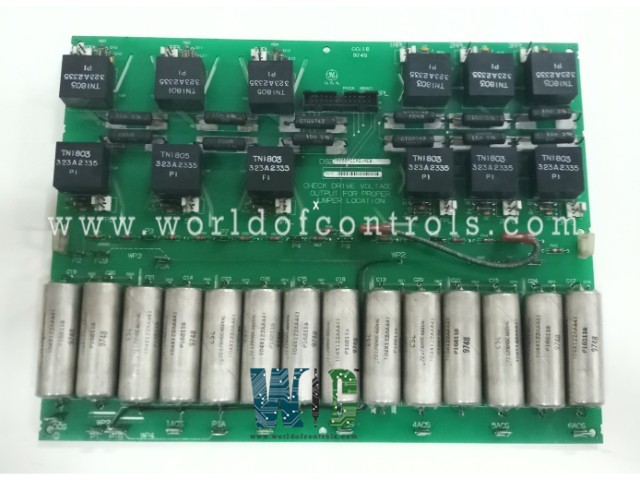
World Of Controls understands the criticality of your requirement and works towards reducing the lead time as much as possible.
IS230PCCAH1B - Core Analog Power Connect Card is available in stock which ships the same day.
IS230PCCAH1B - Core Analog Power Connect Card comes in UNUSED as well as REBUILT condition.
To avail our best deals for IS230PCCAH1B - Core Analog Power Connect Card, contact us and we will get back to you within 24 hours.
Part No.: IS230PCCAH1B
Manufacturer: General Electric
Country of Manufacture: United States of America (USA)
Trip solenoids 3 solenoids per TRPG
Solenoid rated voltage: 125 V dc
Solenoid rated current: 1 A
Product Type: Core Analog I/O module
Availability: In Stock
Series: Mark VIe
IS230PCCAH1B is a Core Analog I/O module developed by GE. It is a part of Mark VIe control system. This module is engineered to handle the acquisition, processing, and transmission of analog signals between field devices and the control system, ensuring seamless integration and reliable data flow across critical operations. The I/O packs in the Mark VIe system form the foundation of its control architecture, managing vital tasks such as signal processing, fault detection, communication, and system diagnostics. Each pack combines advanced hardware and embedded software to deliver precise and consistent performance even in demanding environments. The inclusion of temperature sensors within the design enables real-time thermal monitoring, allowing the system to detect abnormal heat levels early and take preventive measures, thereby enhancing operational reliability and extending component lifespan.
Together, these boards facilitate reliable signal conditioning, communication, and synchronization with the controller network, maintaining the integrity of all analog inputs and outputs within the Mark VIe platform.
The module is equipped with a comprehensive diagnostics framework that continuously monitors its internal circuits and field connections. Fault detection is achieved through a combination of dedicated diagnostic circuitry on the data acquisition board and firmware-level algorithms executed by the processor board.
When an anomaly such as an out-of-range signal, sensor failure, or communication disruption is detected, the module automatically generates a fault status signal. This information is transmitted to the Mark VIe controller, where it is logged and displayed to system operators for immediate evaluation.
This advanced feedback mechanism supports:
The I/O packs support communication with the Mark VIe controller through dual Ethernet network interfaces. This feature provides redundancy in communication, ensuring reliable data exchange even if one network connection fails. This dual-interface approach enhances overall communication reliability between the I/O packs and the control system.
Each I/O pack is capable of transmitting an identification message (ID packet) to the Mark VIe controller upon request.
This data facilitates accurate identification, tracking, and management of I/O pack components within the system.
The module is equipped with temperature sensors, which provide accurate readings within ±2°C. These sensors continuously monitor the temperature within the I/O pack, logging the data into the system database. If the temperature exceeds a predefined threshold, an alarm is triggered, allowing operators to take corrective action before overheating can cause system issues.
It embodies an integrated design by consolidating four separate circuit boards into a single physical assembly. This approach optimizes space utilization within the control system and simplifies the installation process. The integrated design helps streamline the module's integration into the overall Mark VIe control system architecture.
The WOC team is always available to help you with your Mark VIe requirements. For more information, please contact WOC.
What is IS230PCCAH1B?
It is a Core Analog I/O module developed by GE under the Mark VIe series.
What components make up an I/O pack in the Mark VIe control system?
Each I/O pack consists of a generic processor board and a data acquisition board tailored to the connected device. These components work together to digitize signals, execute algorithms, and communicate with the Mark VIe controller.
How does the I/O pack provide fault detection?
Fault detection in the I/O pack is achieved through a combination of specialized circuitry in the data acquisition board and software running on the Central Processing Unit (CPU) board. This comprehensive approach ensures the timely detection and identification of faults within the I/O pack, enhancing system reliability.
How is fault status transmitted from the I/O pack to the controllers?
The Fault status detected is transmitted to the controllers, providing critical information for system monitoring and maintenance. This real-time feedback enables operators to promptly address issues, minimizing downtime and optimizing system performance.